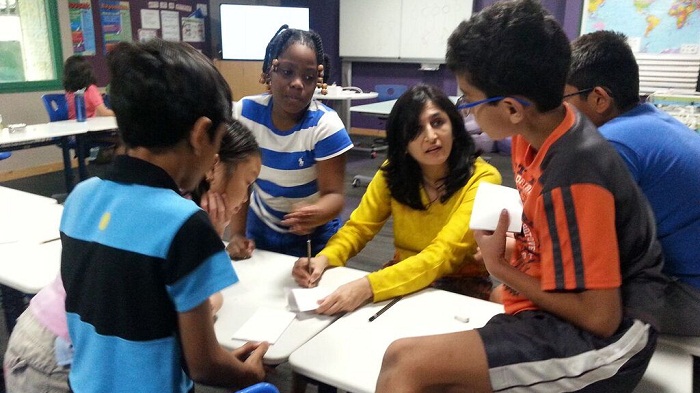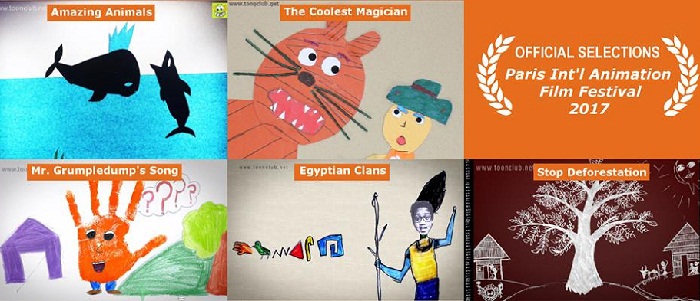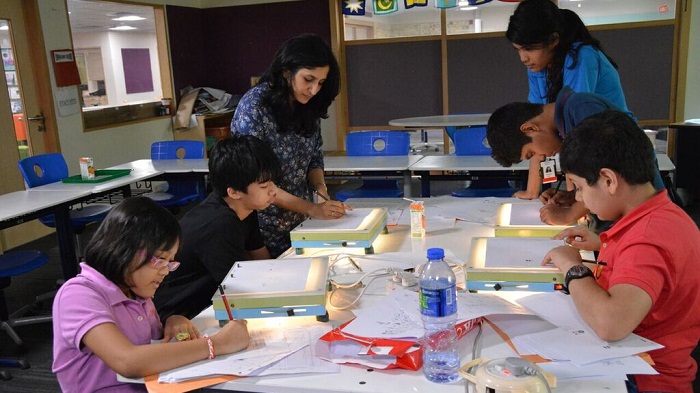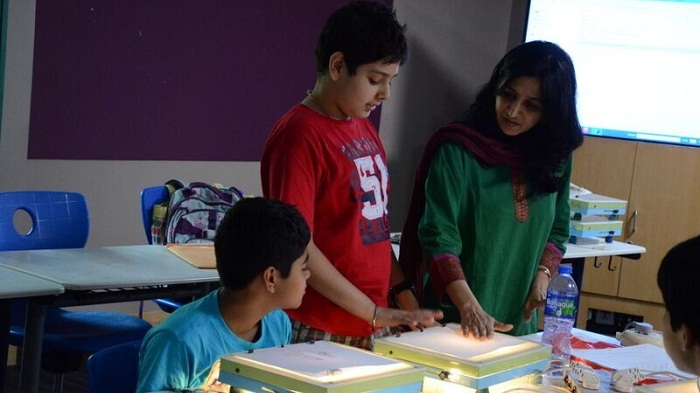
The Paris International Animation festival 2017 will witness some young artists putting India on the map. These prodigiously talented kids will see their short films competing for the honours for the best contemporary creation.
Animation Xpress spoke to Tehzeeb Khurana who is the founder and principal faculty at the Toon Club, Mumbai. It is a pioneering organisation dedicated to teaching children the art of animation.
Tell us about the filmmakers who made the films. How old are they? How did they get interested in doing so? Did you inspire them?
The creators of these five films, which have been officially selected at Paris International Animation Festival 2017, belong to different age groups-

- The Coolest Magician is created by eight year old kids during American School of Bombay’s Intersessions Program
- Egyptian Clans is created by sixth grade students of Ecole Mondiale World School
- Stop Deforestation is created by seventh grade students of Ecole Mondiale World School
- Amazing Animals and Mr. Grumpledump’s Song is created by a mixed age group of kids between 8-13 years at Toon Club’s ‘Toon’ on Saturdays’ program
How did you train them? How much time it takes to learn basic animation and how much it took them to reach to this level?

We usually begin with teaching children the fundamental principles of animation where they understand how a frame-by-frame movement needs to created. This is usually done with various exercises on kineographs or flip books. They learn timing and spacing of drawings to create fast or slow movement. They learn how to morph shapes and other principles like stretch and squash, ease-in/ease-out, anticipation and follow through.
However, a lot of times we have a limited time frame to get children to animate films. Then we simply teach children only those concepts and principles related to the film they are going to produce. Before children begin working on a film, they always create a storyboard and a model sheet.
For example The Coolest Magician was created in only five sessions of two hours each. The participants were new to the concept of animation. So we had to teach them basics, before getting them to storyboard, design characters and props and finally animate frame-by-frame under a camera.
Similarly, Egyptian Clans was created in seven sessions of one hour and twenty minutes each.
Tell us about the concept of the five selected animated films in short. Do they give any message? How long are they?
- The Coolest Magician is a story of a kind-hearted magician. He helps people and animals. Of course, there are times when his magic back-fires on him. But that doesn’t stop him from using his magic to help others. (Duration 1:05 min)
- Grumpledump’s Song is a poem by Shel Silverstein and was created to teach children the art of lip-syncing. Since we had a group of 12 kids working on this, each child was given two short sentences of the poem to animate. They recorded their own voices and then lip-synced the mouth shapes onto their character. (Duration: 1 min)
- The art teacher of Ecole Mondiale was teaching Warli painting to her seventh grade students. Hence, we created the film Stop Deforestation in the Warli art style. This is a story of how growing trees is important for the environment and cutting down trees impacts the eco-system and the lives of birds and animals living on these trees. Deforestation is a harmful exercise and should be avoided as far as possible. (Duration: 2:15 min)
- Similarly, grade six students of Ecole Mondiale were learning about Egypt and it’s art forms. Keeping with this theme, children had to animate their names in hieroglyphics and create an Egyptian costume around their faces in the film Egyptian Clans. (Duration: 2:40 min)
- Lastly, Amazing Animals was inspired by Lotte Reiniger’s Silhouette animation film- The Adventures of Prince Achmed. The film is a story of animals and their behaviour. The world of animals has been explored by the students. Whales, Cheetahs, Bears, Sharks, Crocodiles and kangaroos. Animals come together to help each other at times or at times outsmart each other for food in the wild. (Duration 1:30 min)
Are you expecting a win at the Paris International film festival? How will you react if your students win?
Well, it’s an honour to be selected and we already are super excited. So, if we win (fingers crossed) the excitement will definitely grow multifold.
What do the filmmakers and their parents feel? Their reaction?
All our students and their parents are obviously very happy to hear this news. This is very encouraging for the kids.
How much time it took to create the films?
It all depends on the style, treatment and technique of animation applied for each film.
Children are involved in the creative process. That is, they create storyboards, characters, props, backgrounds and finally the frame-by-frame animation. The technical process of compiling and compositing is handled at Toon Club by our technical team.
The creative process takes approximately five to ten sessions of around one and a half hours each. The technical process takes almost a week.
What animation techniques have been used for the films? How much time it took to make them?
Mr. Grumpledump’s Song is a hand-drawn animation film. Creative process by children took approximately four to five sessions of one and a half hours each.
The Coolest Magician is a cut-out animation (stopmotion) film. The creative process took five sessions of two hours each
Amazing Animals is a silhouette animation technique (similar to Lotte Reiniger’s Adventures of Prince Achmed – the first animated feature film). The creative process took approx five to six sessions of one and a half hours each.
Egyptian Clans is a hand-drawn animation film. The creative process took approximately seven sessions of one and a half hours each.
Stop Deforestation is a hand-drawn animation film. The creative process took approximately eight to nine sessions of one and a half hours each.
Do kids pick up animation techniques quickly? How easy or difficult it is for them?

Most kids are extremely smart and they pick up the concepts of animations quickly. But for some kids, it does become difficult. It’s like any other subject. Some kids have an aptitude for it, while others don’t. So, we have tools to make the learning process easy for all. We usually have a lot of examples, presentations, sample flipbooks and at times sample storyboards to explain concepts to children. All this makes the learning process simple and fun for all.
How does it help them as an individual? Do students think about taking animation as a career?
If at a young age, a child is exposed to all forms of learning, it will help in the overall development of a child. Animation film-making specifically is an amalgamation of many various subjects- art, storytelling, science and mathematics.
It doesn’t matter if the child wants to pursue animation as a career or not. From our years of experience and first-hand feedback from some of our ex-students (who have either graduated or are currently pursuing varied fields including engineering, media, liberal arts or design) their learnings at Toon Club have helped them tremendously.
What are the future projects of Toon club? How do you it plan to popularise animation?
Given the myriad activities and workshops that are available to children nowadays, only a few are drawn towards animation. Besides many are interested in computers and not wanting their children to learn the fundamentals, art and craft of animation.
We work with a small group of students and limited number of schools.
We are happy to be a part of Ecole Mondiale World School since 2004. Ecole Mondiale has made animation a part of their school curriculum. We hope that other schools too see value in this subject and come forward to make it a part of their curriculum. That’s our future growth area.
What are the recent achievements of Toon club? Tell us about any other awards Toon club has won.
We have won 16 awards since our inception in 2003. Toon Club has been awarded by ASIFA India (Association of International Du Film D’ Animation) for contribution to Indian animation. We recently received the ABAI Make a Difference Award 2015 for our contribution in spreading social messages using animation as a tool and ORBIT LIVE 2016 Award for our unique contribution to animation industry.
Another achievement that we are particularly proud of, is that one of our award-winning films on child rights “Children of the World” is now a part of an educational kit that goes to ever child studying in a Croatian school.
You have been teaching animation to kids since a long time. What makes you enthusiastic and driven about it for such a long time?
We started Toon Club in 2003 and we’ve taught animation to 100s of kids since then. Some of these kids went onward, joined NID, Srishti, JJ school of Arts, Ecole Intuit Lab and other art/design colleges.
I am passionate about teaching new stories, styles and techniques of animation with children. In the ‘Toon’ on Saturdays program, we explore something new each time and topics are rarely repeated. This keeps me challenged and helps me learn and grow as well. We constantly look for new stories to tell and new techniques to tell these stories. This has helped Toon Club create a diverse portfolio of styles and stories. This is what makes me enthusiastic and driven even after so many years.
Do you learn from the kids at times?
All the time. I learn more from the kids than they learn from me. Unlike most adults, each child is highly creative and unique. Their curiosity is infectious.
How is your teaching style? How long are the classes? Give a brief idea about your classroom training.
I believe in making learning a fun experience. My students come to have fun at Toon Club. The learning, creativity and films just happen by the way while they are having fun. A typical class would be approximately one and a half to two hours long.
We teach children the history and definition of animation, frame concept, persistence of vision and laws of physics, optical devices (thaumatrope, phenakistoscope, zoetrope and kineographs), principles of animation (stretch and squash, ease-in/ease-out, timing and spacing, anticipation-action-follow through, drag and snap principle etc), various techniques of animation (hand-drawn, pixilation, cut-out, rotoscopy, lip-sync, sand animation, silhouette, clay animation, bead animation etc).
What is your message to students who want to learn animation and to the parents?
Children watch a lot of cartoon films. Animation makes for a perfect platform for kids to tell their own stories. As the frame-by-frame animation process requires certain amount of dexterity, it helps develop a child’s motor skills, hand-eye co-ordination and also qualities of patience and perseverance.
We wish Toon Club and the kids all the best for Paris International Animation film festival!

